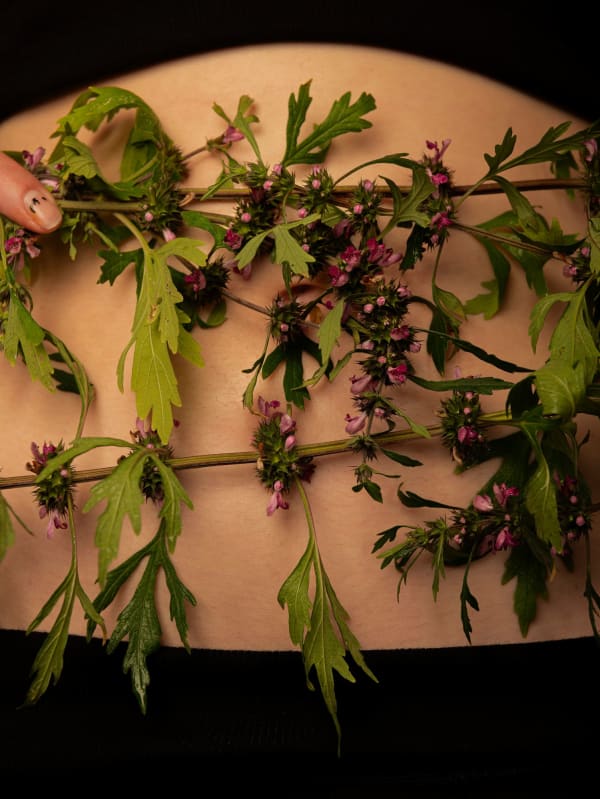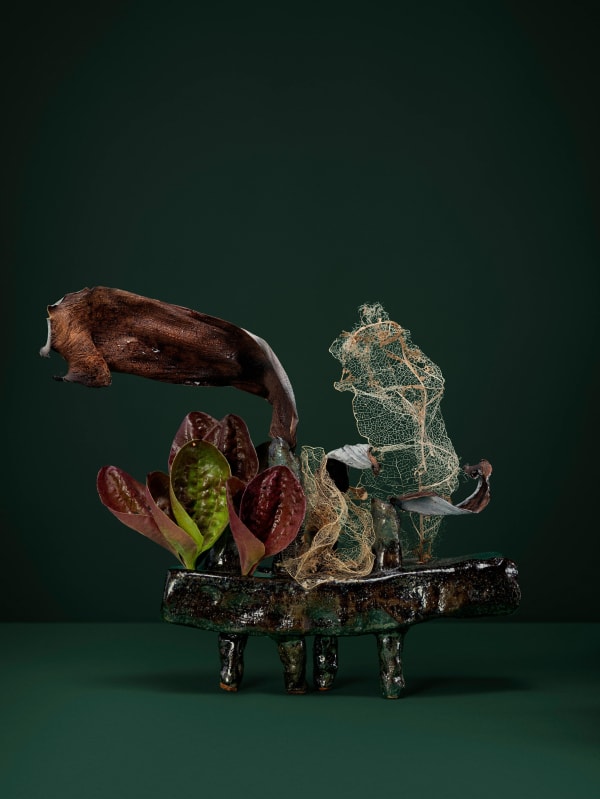-
"i am an old phenomenon casts Shelton in the roles of gardener, artist, image maker, forager, and researcher. As with her ongoing internationally successful series jane says, Shelton continues her investigation into the forgotten and suppressed histories of plants and knowledge of their healing and spiritual effects. As with jane says all the plants are gathered, arranged, and photographed by Shelton, many of which she also foraged or grew from seed."
Systems of belief concerning the medicinal, magical and spiritual uses of plant materials were well established in the lives of European forest, nomadic and ancient peoples. However, these beliefs were forcibly supplanted as pagan practices were displaced across Europe and other continents in the wake of Christianity and the rise of capitalism. The consequences of the suppression and attempted erasure of this plant-based belief system continue to be profound. Knowledge, often held by women, of the healing and spiritual effects of plants has been replaced by a significantly more limited emphasis on their predominantly aesthetic qualities. This separation informs our contemporary relationship to plants as being primarily one of commodification.
The images in i am an old phenomenon are part of the re-assemblage of fragments of this old knowledge and, in their ontology, invoke the persecution of wise women, witches and wortcunners who kept this knowledge safe but whose understanding of plants and their connection with reproduction, in particular, represented a threat to the new order. All the plant sculptures photographed are constructed by the artist who has always been interested in the history of floral art and its expansive gendered resonances, having worked with plants since childhood.
In recent iterations of the series, Shelton has begun growing many of the featured plants herself—from seed to harvest. This shift introduces a durational and embodied aspect to the work, reflecting the slow, attentive process of analogue photography and reinforcing the artist’s commitment to care, cultivation, and recovery.
Three visual modes structured the early works in the series: the aerial, the earthbound, and the submerged. More recent works incorporate scorched arrangements, and the body, expanding the visual language to include rupture, resistance, and embodied presence. These images carry ritualistic and alchemical resonances—speaking to both historical persecution and contemporary urgency, particularly around bodily autonomy and reproductive rights.
The first iteration of the series was accompanied by Shelton’s award-winning publication worm, root, wort... & bane (2022)—part artist scrapbook, part photo book, part quotography, and part exhibition catalogue. The book interweaves Shelton’s photographic works with archival material and historical research into the cultural suppression of plant-based wisdom.
-
-
-
A Leap of Faith, Ann Shelton: Plants and parts of plants at Jhana Millers Gallery
Heather GalbraithThe potencies and resonances of plants have long fascinated Ann Shelton. Early explorations interrogated and documented sites of trauma, where landscape and built environment images enabled urgent discussions around how events as diverse as matricide, the abduction of young women, experiences in mental health and addiction facilities, among others, have been felt and understood. Within these series, there was highly attentive looking and framing of tamed and uncultivated vegetation.
With the series ‘jane says’, analysis of environment shifted to a deep curiosity about plants, still thinking through trauma, but with a focus on a single plant, its uses and applications. In this new body of work, Shelton is compelled by instances of lost wisdoms, co-opted potencies drawn primarily from European, medieval, pagan, pre-Christian, and ‘folk’ contexts relating to plant-based tonics, tinctures, and poultices, particularly those used in treatment relating to reproductive health, centred around the wise-woman or healer. She explores how dominant taxonomies and value systems have subjugated and denied knowledge held in customary and community contexts, for the explicit purpose of disempowering sections of society and selectively assimilating knowledge of holistic healing within frameworks of ‘ownership’ and commodification.
Her process includes researching and collecting references and information from a myriad of sources, relating to specific plants. Initially she built a gargantuan spreadsheet of plants and their properties; her process extended to creating detailed reference journals, ordered plant by plant, accumulating every reference and association. These informed her shooting journal where she brings the subject matter into sketched compositions, taken into testing and refining through the studio set-up. This rich research-engaged process (which itself can echo the durational patterns of growth of the plants she is imaging) involves a potent distillation of associations, applications and symbolic resonances into an intense visual synthesis.
In recent years, Shelton has been cultivating and nurturing seeds and seedlings, a process that has enriched her understanding of plants. Time is a key component, as is sunlight and warmth, and a heightened awareness of seasonal variations. These parameters are not conceptual or theoretical, they are lived, felt, highly corporeal, while also drawing plant knowledge gained over time.
As all avid gardeners will attest, it is an undertaking equal parts exhilarating and heartbreaking. While you do your best to offer optimum conditions, ultimately the plants are in control. Their agency is paramount. We can only try to attend to a complex range of needs and factors, with dedication.
Shelton has observed a worrying contradiction—the increasing struggle of getting access to a broad spectrum of plants and seeds, all the while more folk are getting enthusiastic about tending their gardens. Nurseries and seed sources are closing, specialist cultivators and wholesalers are struggling and choices are becoming more oriented towards a limited and unimaginative range of “potted colour” within generic chain DIY stores. Local communities of plant and seed swap societies are aging. Everything feels out of whack, and biodiversity is suffering, as is the intergenerational transfer of knowledge.
Like so much of Shelton’s work, she is driven by the impetus to bring to light overlooked or quietened wisdoms and perspectives. Compelled by feminist ideals, ecological worries and a strong awareness of the complicit nature of the colonial project—and how our high capitalist system and fiscally-driven globalisation has fuelled these developments—her project is both political, and also at its core, hopeful. The exquisite worm, root, wort…& bane that accompanies this series is a book of generosity, corralling a myriad of text and visual references to plant species and their applications in holistic healing in multiple cultures, and also the persecution of witches, crones, herbalists, pagans, and other diverse knowledge holders. The book hosts a babble of voices and sources, sometimes conflicting, presented in thematic rather than chronological groupings.
Shelton’s deep engagement with plural and often subjugated knowledge systems contrasts with the biological classification set up by Swedish biologist Carl Linnaeus in the mid 1700s. In texts Species Plantarum (1753) and Species Systema Naturae (1758) Linnaeus foregrounded a highly influential classification system based on the reproductive parts of a plant (rather than their appearance). This brought a simplified, consistent systemisation to nomenclature that remains in use today. However this consistency relied on obliterating any plurality of naming, which in turn quietened ‘anecdotal’ or varied naming derived from their application and purpose across a range of cultural and geopolitical contexts. Within the titles of the works presented here, there isn’t a hierarchy of information, no one version of a name is held to be more valuable or proper, Linnaeus’s names are however absent.
Much of the foliage in these new works for ‘i am an old phenomenon’ is impolite, wonky, leggy and crooked in many instances. They bear the qualities of their time in the elements and their responses to this stimulus (or these stimuli). This skew-whiff verdancy has not been edited (or genetically modified) in order to adhere to an aesthetic of ‘perfection’ found in commercially grown plants. Shelton attests to the plants being the ones in charge here, and that the garden does what it does. The compositions of the eight works selected for this presentation are discernibly chaotic, real and full, there are aspects of lushness, but also strong evidence of entropy, and of an extended life cycle of the plant. This is amplified by the integration of the waterlogged images, the foliage that has been submerged into a tank and encouraged to ferment, to release its potencies into the stagnant water, not dissimilar to processes involved in the distillation of tonics or tinctures. The imagery occupies the full frame, veritably bursting forth.
Enter the human form, drawing closer to the surface the relationship of humans to plants; as holders of plant knowledge, and humans being in receipt of healing and fortification. In Siberian mother wort: the appearance of a Lion (Siberian motherwort, honeyweed and marihuanilla, little marijuana, Chinese motherwort, or Sibirisches Herzgespann—German for Siberian Heart's Delight, Throw-wort, Lion's Ear, Lion's Tail, and Wild Dagga), there is a pale torso with a tummy button wearing plain black underwear framing the foliage they are holding across their body. Siberian motherwort had a myriad of uses including to treat gynaecological issues (including treatment of anxiety during childbirth, through to perimenopause and menopause). It is also understood to treat melancholy, hysteria, and to support cardiovascular health and aid astral projection. These many and varied properties are not consistent through the range of references and accounts, and in some cases are contested.
Also referencing the body and its capacity for transformation, the Persimmon has intrigued botanists for centuries because of its ability to switch between different biological sex attributes. Whether through gene activation, epigenetic regulation, or grafting, the Persimmon has the flexibility and survival mechanism to produce both male and female flowers. A human trans body is unable to reprogramme its biology like a Persimmon, but it can undergo hormone therapy and be grafted via the skills of a specialist surgeon. However, unlike the grafted Persimmon, the surgically confirmed trans body is self-determined. In Aligning physical appearance with gender identity (Persimmon, American Persimmon, Common Persimmon, Eastern Persimmon, Possumwood, Winter Plum, Possum Apples, Fruit of the Gods, kaki or Sharon fruit), a mid-transition FTM torso is visible. His chest surgery is collapsing and has been redone by his genital surgeon since this photo was made. He is holding a branch of a fruiting Persimmon with both hands down the front of his in flux body. Through the leaves we may see procedural marking on the chest and abdomen heading towards the genital zone. The FTM for this image is, a past girlfriend of the artist, who was two surgeries short of a full medical transition when this photo was taken.
In Betony Trade your coat for Betony (wood betony, common hedgenettle, purple betony, bishopwort, or bishop's wort, hairy nette, devil’s plaything) the plant, with its roots attached are clasped by a ghostly white hand. The qualities of the skin belie both advancing age and submersion in water (some fine hairs have trapped tiny air bubbles close to the skin). Betony is a member of the mint family Lamiaceae, native to Europe, western Asia and northern Africa. Historically, Betony has been highly praised, including a reference by Pliny the Elder in Naturae historiae (77 CE) that betony was “a plant more highly esteemed than any other”, and while a panacea for many ills in the Middle Ages, there are also references within Greek literature to its virtues. It was believed to ward off evil spirits, and was planted near churchyards and worn within amulets or charms around the neck (noted by both Erasmus and Apelius)[1] Betony was one of the most challenging plants for Shelton to grow, and it took four years to get enough to photograph.
Shelton likens plant cultivation to photography, in that both require a leap of faith. They both stem from a period of darkness, and are reliant on transformation through light. There is an emerging of something out of ‘nothing’. They require time (albeit with different time signatures) and are subject to contested attempts to classify and organise information.
Heather Galbraith
Ann Shelton, i am an old phenomenon
Current viewing_room
















![Ann Shelton, On certain days or nights she anoints a staff and rides (Brugmansia, Angels Trum- pet, Snowy Angel’s Trumpet, Angel's Tears, Datura [misleading]), 2022 ongoing](https://artlogic-res.cloudinary.com/w_600,c_limit,f_auto,fl_lossy,q_auto/artlogicstorage/jhanamillers/images/view/5433a88b78ff247eae2fa5a4d916165e/jhanamillersgallery-ann-shelton-on-certain-days-or-nights-she-anoints-a-staff-and-rides-brugmansia-angels-trum-pet-snowy-angel-s-trumpet-angel-s-tears-datura-misleading-2022-ongoing.jpg)











